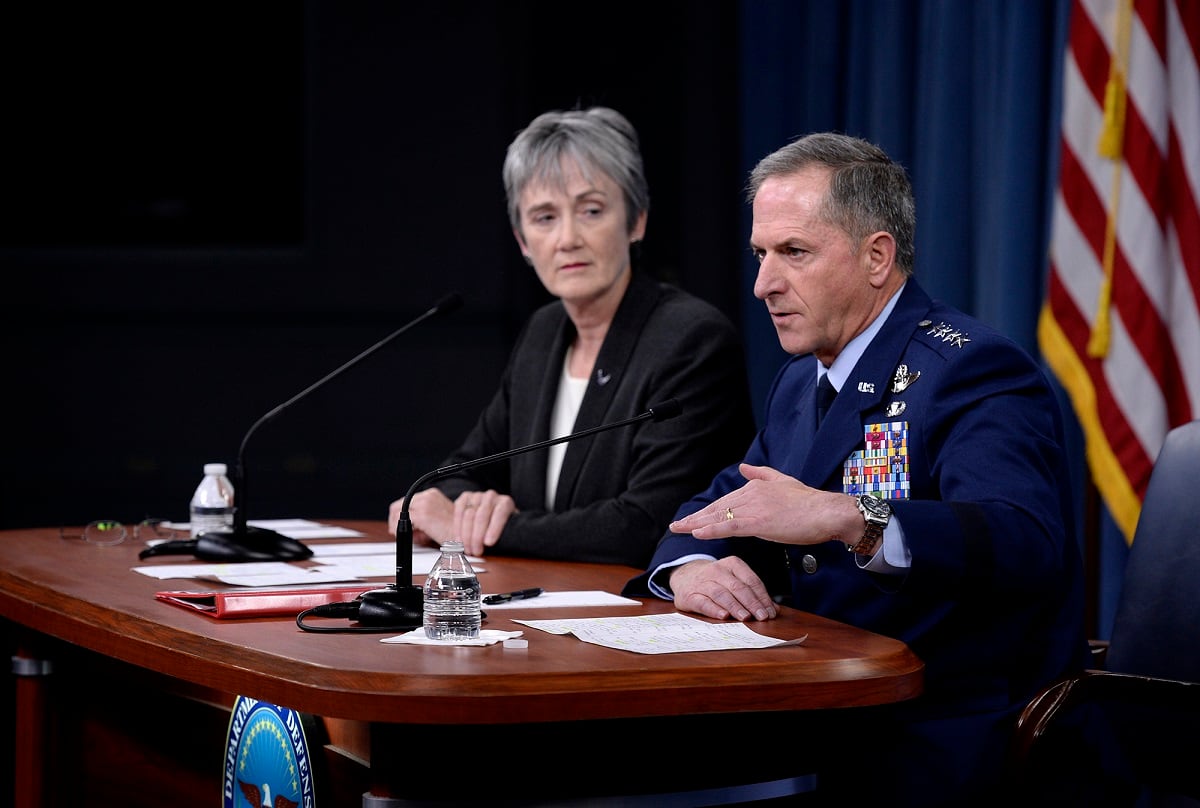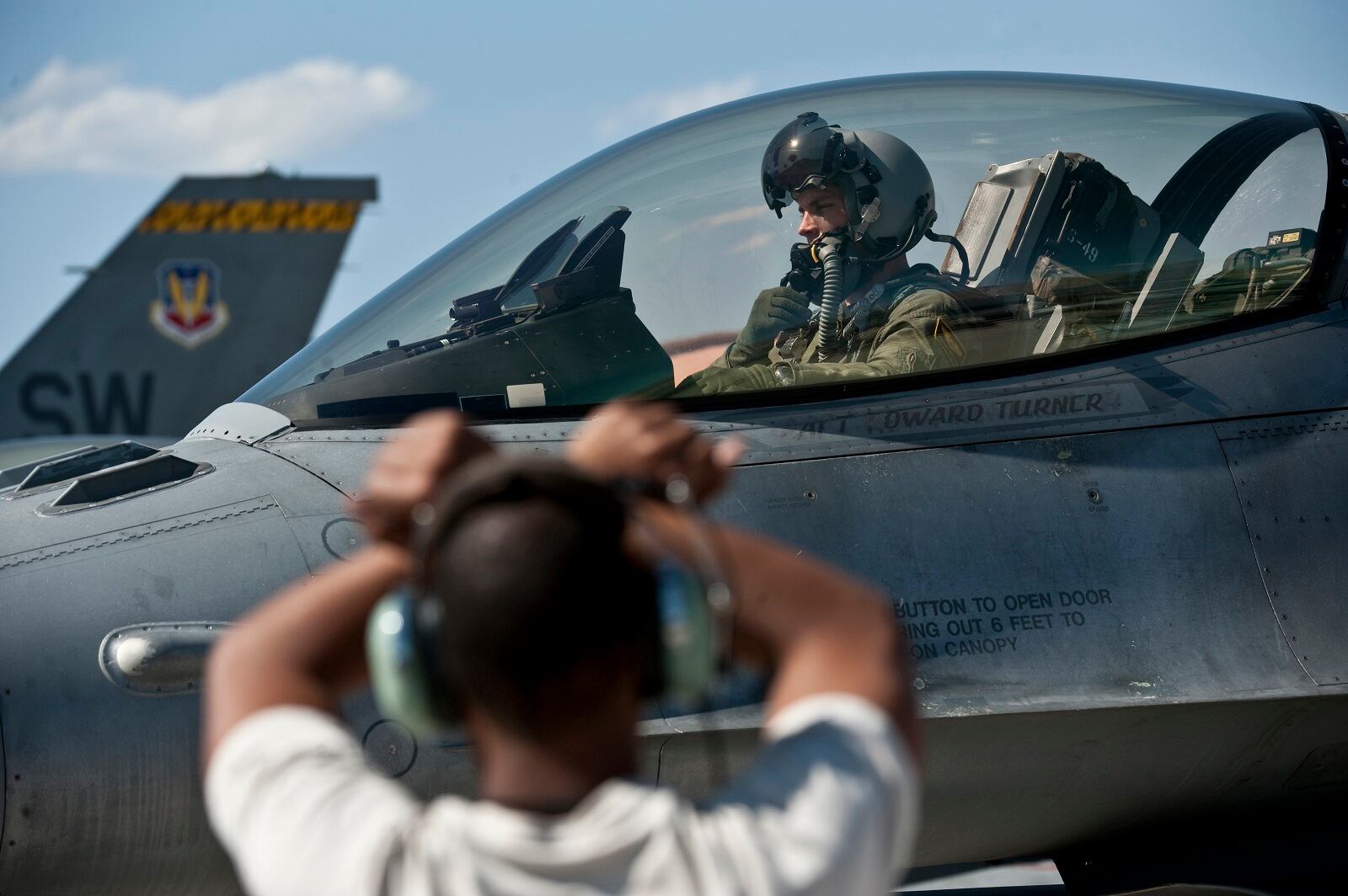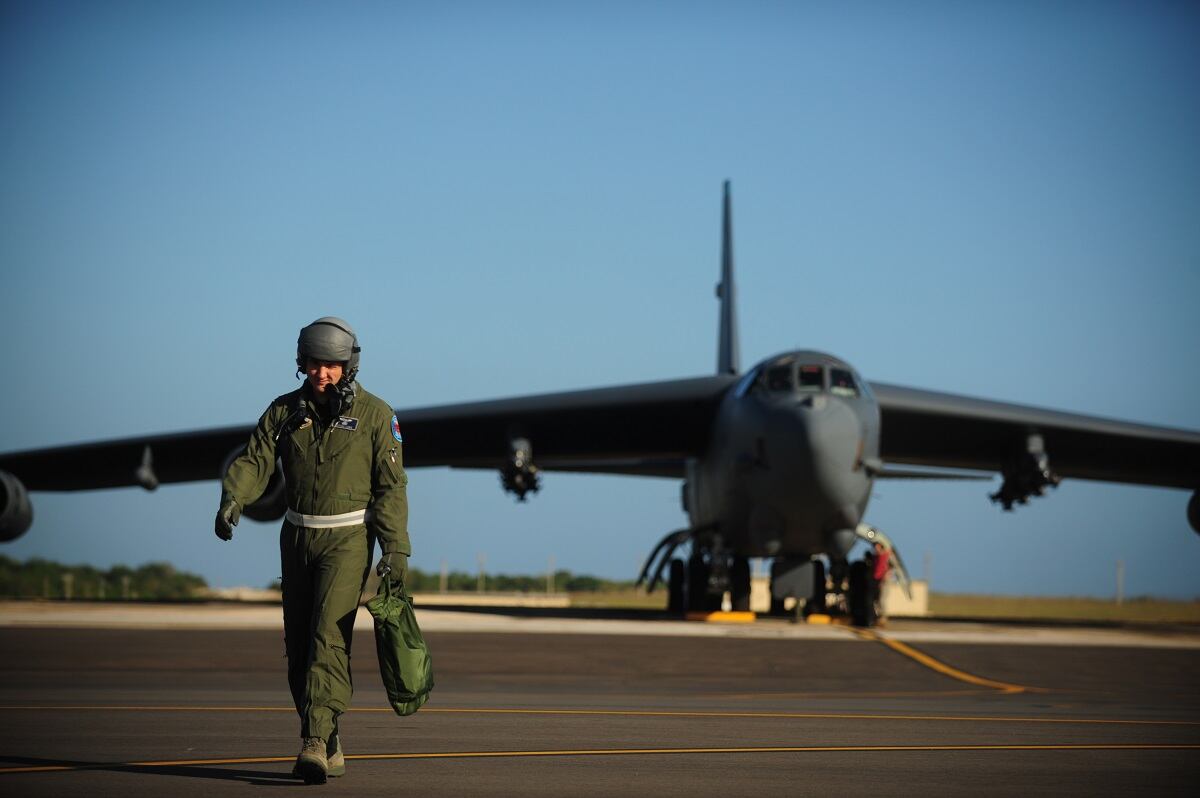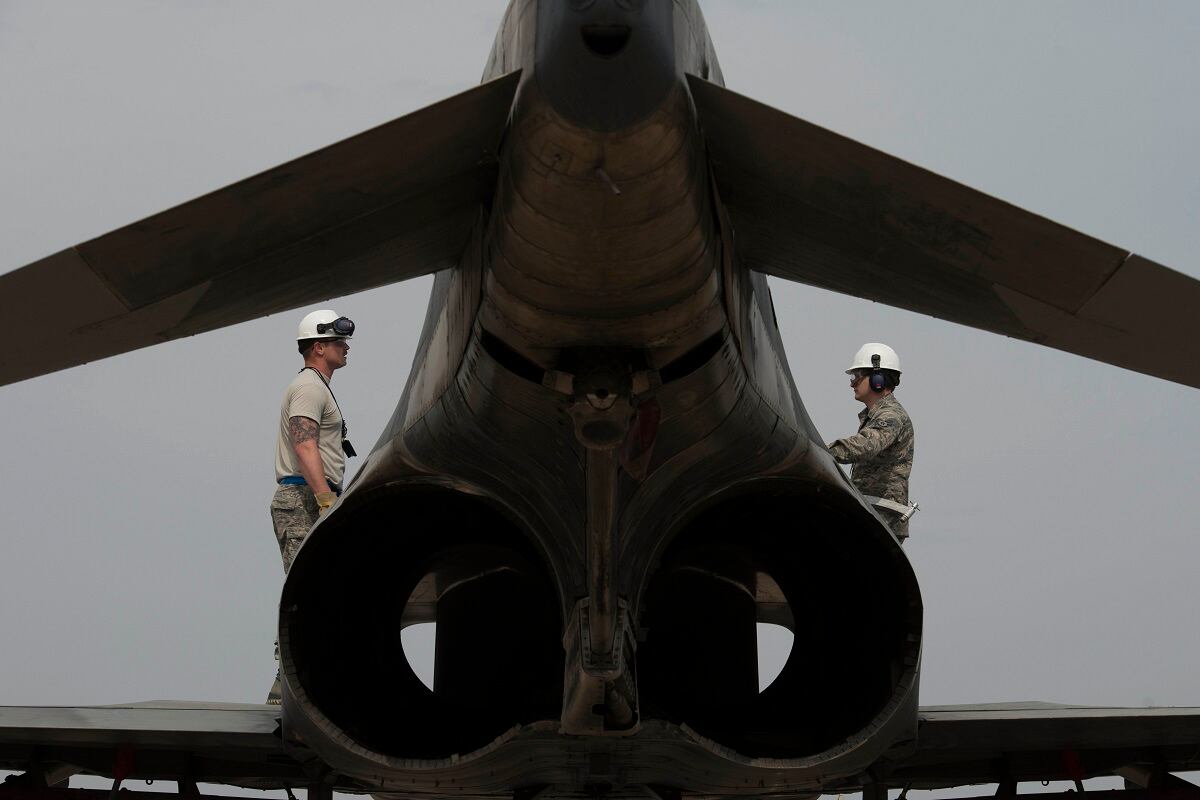The Air Force has worried for years about its shortage of pilots, maintainers and other crucial airmen.
But now, top Air Force leaders are sounding a red alert: The manning situation of some of its most vital airmen is growing worse and worse, with no end in sight if current trends continue.
And if things don’t change — particularly the ongoing budget caps known as the sequester — Chief of Staff Gen. Dave Goldfein said the problem is going to worsen until the Air Force struggles to fight overseas.
So far, the Air Force has been able to keep its pilot shortage — now numbering almost 2,000 pilots — stateside and fully man its deployed squadrons. But at this rate, Goldfein said in a Nov. 9 briefing at the Pentagon, that could change.
“What keeps me up at night is if we cannot move past sequester in its current form, we are going to break this force,” Goldfein said, adding that “if we don’t turn this around, then we’ll end up heading down that path” of deployed squadrons suffering.
The worsening pilot shortage is the most visible symptom of the Air Force’s chronic manning emergency.
At the annual State of the Air Force news conference Nov. 9, Goldfein and Air Force Secretary Heather Wilson said the pilot shortage has swelled to roughly 2,000 pilots, a shortfall of about one in 10. That’s a significant increase from earlier this year, when the Air Force said it was 1,500 pilots short.
The pilot shortfall is most acute in the fighter pilot ranks, which are now 1,300 short, Air Force spokeswoman Erika Yepsen said in an email.
But the problem is growing in other pilot categories too, she said. Between fiscal 2016 and 2017, Yepsen said the Air Force saw the greatest negative trends in its bomber and mobility pilot ranks.
Yepsen said the 2017 numbers are more comprehensive because they include all categories of pilots, including remotely piloted aircraft pilots, which weren’t included in the 2016 statistics.
Pilots aren’t the only short-staffed career field contributing to readiness problems. The Air Force’s maintainer ranks have been undermanned for years, reaching a low point in 2015, when the service was short 3,755 of them. That’s 6 percent lower than what it was authorized. The Air Force has slowly made progress on maintainers, and earlier this year expected that shortfall would drop to about 2,500 by the end of 2017.
More than a quarter-century of combat operations and budget uncertainty have created an operator retention problem beyond the pilot ranks, Lt. Gen. Mark Nowland, deputy chief of staff for operations, told the House Armed Services readiness subcommittee Nov. 9.
For example, he said, AC-130 gunners is now the most-stressed career field.
He also said the Air Force needs to surge its production of operators in air, space and cyberspace.

With the Air Force apparently unable to effectively turn around the pilot shortage and no relief to the punishing operations tempo in sight, John Venable, an expert with the Heritage Foundation and Air Force veteran, fears the service could be looking at a death spiral.
He worries that after years of warnings from Pentagon leaders about the state of the military, lawmakers on Capitol Hill don’t even hear them anymore.
“If you are riding a horse in a combat environment, the horse is not going to tell you, ‘Hey, I need to stop,’ ” Venable said. “It’s going to continue to give you everything it can until it keels over and dies. And right now, Congress is seeing the horse underneath them, they’re whinnying a little bit, but they’re continuing to take the fight to the enemy. And, unfortunately, we don’t have the knowledge in Congress, or the care, that says you’re about to ride your horse until it falls underneath you.”
The fact that Goldfein is openly discussing the possibility of combat capabilities degrading is a sign of how bad things are getting, Venable said.
“It’s a big deal,” he said. “If you convey weakness to an enemy, then you expose yourself to that enemy.”
Even with President Trump expanding the Air Force’s authority to recall retired pilots to serve as instructors and in staff positions, the service is emphasizing that it has no plans to bring retirees back involuntarily.
“We are an all-volunteer force,” said Brig. Gen. Mike Koscheski, who heads a task force dedicated to fixing the pilot shortfall. “That is our focus.”
But Venable wonders whether the Air Force will need to resort to more drastic, involuntary recall measures, including invoking stop-loss.
“I don’t think there’s much the Air Force can do right now ... except invoke stop-loss in order to stop this gross departure of pilots,” Venable said. “I had the chief of staff here at the Heritage Foundation [at the beginning of the year] and he said stop-loss is not on the table. But, at one point or another, you’ve got to maintain your combat capability. And if they can’t ... I think he’s going to have to [consider] stop-loss. It would be draconian, everybody would hate it. But I’m not sure what their alternatives are going to be.”
RELATED

‘New normal’
The Air Force has rolled out a wide variety of programs over the past year and a half to try to stem the pilot shortage.
They include:
- Dramatically increasing retention bonuses — up to $455,000 in some cases — to try to convince pilots not to leave for lucrative commercial airline jobs.
- Receiving permission from the White House to bring back hundreds of retired pilots, some of whom will serve as instructor pilots.
- Adding more support staff to take over administrative duties that were keeping pilots out of cockpits.
- Working to increase the training pipeline. The Air Force now produces 1,200 new pilots each year and is working to get that up to 1,400, although officials say it needs to hit 1,600 to keep up.
But even with all those programs, the problem continues to worsen.
When asked why at the news conference, Wilson pointed to the relatively small size of today’s Air Force compared to the wide variety of missions it is being asked to carry out against the Islamic State, in Afghanistan, supporting the effort to pressure North Korea, and elsewhere throughout the world.
It’s taking a toll on airmen, she said — especially pilots.
“We’re burning out our people,” Wilson said. “Surge has become the new normal in the United States Air Force. You can do that for a year, or two years, maybe even three or four years. But I met someone last week who has just come back from his 17th deployment. Seventeen deployments. And at some point, families make a decision that they just can’t keep doing this at this pace.”
RELATED

What’s making things worse, Venable said, is that after airmen return from months overseas, they often have to go on “baby deployments” stateside for training or other temporary assignments.
Airmen have heard promises from leaders for years now that they’ll add more support staff, increase flying time, fix the ops tempo, and otherwise improve their lives, Venable said.
“But there’s been no action to go and fix these things,” Venable said. “The challenges are higher than they’ve ever been, and the rationale and the explanation and the promissory notes are no different than they’ve been in the past.”
Venable said it’s not surprising airmen continue to leave. A shortage of spare parts, munitions and available flying hours for the pilots the Air Force does have also is contributing to the problem.
Pilots are flying about 25 to 30 percent fewer hours than they were in the 1990s, Venable said. Not only is that dampening morale, he said, it’s creating a dangerous situation where pilots don’t have the experience they need to stay safe in the air.
Airmen on the flightline have been told that 150 flight hours each year — or about two sorties a week — is as good as it’s likely to get, Venable said. But they need at least three weekly sorties to maintain their combat readiness, he said, and four to improve. Pilots need another 50 to 60 flying hours each year, he said.
Not just pilots
Goldfein said the lack of maintainers is having an effect on readiness.

When Goldfein started flying F-16s in the 1980s, he would meet his crew chief and a secondary crew chief before each flight. They’d walk around the plane, he’d taxi out, and then meet another crew on the runway that would pull the pins to arm his weapons and give the plane one last look before taking off.
He’d then fly to another base and meet a different crew to do the necessary post-flight work on his jet.
But today, he said, some pilots must take their time as they taxi because there’s often only one crew chief, who has to get in a van and drive to the end of the runway to pull the pins. And then the pilot has to wait before taking off because that same crew chief has to hitch a ride on a C-17 to fly ahead and meet that pilot at his destination.
“This is the level of numbers that we’re dealing with here,” Goldfein said. “We’re making the mission happen. But we’re having to do it very often on the backs of our airmen. The tension on the force right now is significant.”
The Air Force is continuing to try to increase pilot production to fix the problem in the long term. But it is going to take years, Wilson said, to properly train and absorb these pilots to the point where they are effective.
And Congress needs to help out by lifting the sequestration caps that have limited the service’s budget, they said.
“If we go through the sequester again, a 2,000-pilot shortage will be a dream,” Wilson said. “People will walk.”
Stephen Losey is the air warfare reporter for Defense News. He previously covered leadership and personnel issues at Air Force Times, and the Pentagon, special operations and air warfare at Military.com. He has traveled to the Middle East to cover U.S. Air Force operations.





